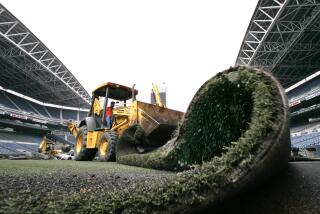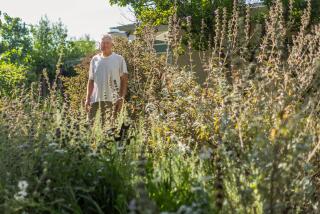Getting rid of grass is making homeowners’ wallets greener
- Share via
If somehow you missed the news that California is drier than a stale tortilla, the Amber Alert signs have come to the rescue with highway bulletins like this one:
“Serious drought, help save water.”
This is helpful to a point, I suppose, and I like the creative use of highway signs heretofore reserved largely for safety warnings or child abductions. If Caltrans would consider pushing the boundaries even further, I’d spring for a sign that says: “Hey, Brian D’Arcy, where’s our $40 million?”
But as for the drought, I wish the messages were a little more specific. They might, for instance, offer the following suggestions:
“Shower with a bucket, or a friend.”
“Use the car wash, not the hose.”
Even better, though, would be a message like this:
“DWP will pay you to rip out your lawn.”
And it will. The current deal is that the Los Angeles Department of Water and Power will pay $2 per square foot, up to $4,000 total, if you replace water-guzzling grass with drought-tolerant landscaping. Imagine that — the DWP sending you money instead of siphoning it right out of your wallet.
DWP spokesman Joe Ramallo said that in the six months that ended Jan. 31, residential and commercial customers ripped out 813,000 square feet of turf. Since 2009, 6.6 million square feet of grass have become history. Ramallo said there was a tenfold increase in applications last fall, when the price per square foot went up from $1.50.
Long Beach is offering $3 per square foot in its lawn-to-garden program, with a maximum payout of $3,000. Kevin Wattier, general manager of the city’s water department, told me there’s been a spike in applications since the city upped its payment from $2.50 a square foot.
Wattier said that on average, about 50% to 60% of residential water use is for irrigation, and property owners who’ve dug out their grass are saving roughly 20% on their water bills.
Long Beach homeowner Steve Crowe took the bait. “We had a couple of palm trees and grass, and now we have a drought-resistant, succulent garden, and it’s been an extraordinary pleasure,” he said. “It’s a frontyard that catches people’s attention.”
Crowe made his conversion in 2012 and pocketed $2,200.
Anna Bjornsdotter and her husband, Jose Lopes, made the switch to drought-resistant for environmental, economic and aesthetic reasons.
“Lawns are boring, and I didn’t want to waste water on one,” said Bjornsdotter. “We have sage, a couple of different fuchsia, some fruit trees and a gray-water system from our washing machine.”
Lopes was weeding the garden when I visited Friday, with butterflies and bees keeping him company. He and his wife said they don’t use any water for plants other than the recycled gray water.
When they hauled away their grass, in 2010, the city paid them $2,500. They plowed that money back into their new garden, breaking even, more or less. But Lopes said he’s happy to have retired from lawn-mowing.
Steve Fleischli, an attorney with the Natural Resources Defense Council, lauded Long Beach for this and other conservation methods. In 1980, he said, Long Beach residents used 192 gallons per person daily. By 2010, they were down to 110 gallons.
In his water policy blog last week, Fleischli said there are two ways to look at the drought.
“It’s not just a lack of precipitation that’s causing the problem,” he wrote. “For far too long Californians have used more water than we can sustain.... This system of too little supply and too much demand is finally catching up with us. And as climate change becomes the new normal, our water woes will only get worse.”
Fleischli said as much as 80% of California’s water is used for agriculture, this being the nation’s most productive food-growing state by far. But we still have too many crops — such as alfalfa and cotton — better suited for wetter climates. And too many farmers are still using wasteful “flood/furrow irrigation” practices, said Fleischli.
“More than 50% of the state’s 8 million acres of irrigated land relies on clunky, outdated systems,” he wrote in his blog, recommending public-private partnerships and more state incentives for conversion to better irrigation systems.
As for homeowners, Fleischli supports Gov. Jerry Brown’s call for a 20% reduction in water use, and he sent me a list of recommendations, most of them pretty obvious. Fix leaky sprinklers, never over-water, repair toilet and faucet leaks, convert to appliances designed for lower water use, cover your pool to avoid evaporation, and, as mentioned, go native.
“I like the fact that I’m conserving water, and in this day and age, I can’t believe how many people continue to water their lawns,” said Long Beach resident Donna Warshauer. She and her husband, Steve, replaced turf at their home and two rental properties with drought-resistant landscaping. “We don’t have a gardener and we don’t have to water, and I like it that way.”
To check on the availability of turf-replacement programs where you live, call your water department.
If you’re in the Metropolitan Water District, the details are at https://www.socalwatersmart.com.
If you’re an LADWP customer, go to https://www.ladwp.com/CF.
To get in on the cash-for-turf action in Long Beach, go to https://www.lblawntogarden.com.
Even if no programs are available where you live, borrow some of Justin Bieber’s eggs next time you see some moron’s sprinklers flooding the street, and let him have it.
And if it ever does rain again in California, be prepared and catch it in a barrel. Actually, a small jar should do the trick.
More to Read
Sign up for Essential California
The most important California stories and recommendations in your inbox every morning.
You may occasionally receive promotional content from the Los Angeles Times.











